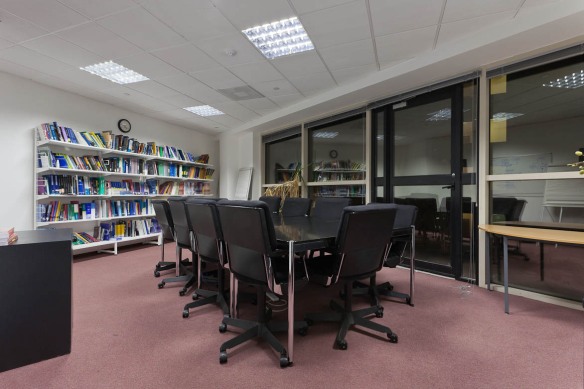Project brief
Take one or two locations where I can conveniently return a number of times in different lighting and photograph on each occasion. To get full value from this project, consider making two variations of photograph. In one, set the camera up in exactly the same position each time. In the second, see how the different lighting positions suggest different viewpoints and compositions.
P18-A
This first shot was lit by a large north facing window around the middle of the day. The room is a boardroom /large meeting room. The building is surrounded by a number of larger high rise buildings and so outside of this time of day, light levels, particularly in December, are very subdued. Like all the images in this project, this was made using a tripod and a two-way spirit level that ensured that the camera was level horizontally and vertically. Despite this attention to detail, and the use of lens correction profiles in Lightroom, the use of a very wide angle lens has introduced some distortions into the images – although the course notes emphasise that this section is not about architectural photography.
One thing that caught my attention as a result of making this image was the reflection of the books in the surface of the table, (at the far end of the table). I made a few images of these reflections which worked technically but did not make interesting images – mainly due to the horizon of the black table edge and the fact that the rear wall in this image is not square but runs at an angle. This latter fact meant that the reflections and shelves appeared uncomfortably distorted.
P18-B
When darkness began to fall I moved my camera position. The window area that would have overpowered daylight images can now be rendered in relatively dark tones. This has the effect of making the board table seem more prominent and dominant within the room. The new camera position also seems to make the room more spacious. The fact that the room is not rectangular has also become more apparent.
P18-C
Whilst making P18-B I realised that there was potential for an unlit shot in which I would have to rely upon light sources outside the room. A glass panel in the door provided a useful shaft of light across the floor and ceiling. The relative darkness of the room meant that the relationship with the outside world changed significantly from P18-B and the outside is now brighter and more prominent. At a stretch, these changes in how the space is lit perhaps communicate that work is over and people are outside enjoying the evening.
P18-D
The change to night time also led to a new camera position seeking to highlight the relationship of the room to the external environment. The lights of Canary Wharf are brightly visible from this room and I have combined two images to accentuate the contrast in the window area. The room too, and by implication its potential occupants, now appear more outward facing and potentially engaged with the exciting commercial world outside. Ideally, I would have been able to move the dying pot plant before making the image but this didn’t prove to be feasible and so I decided to picture the room exactly as it was. The absence of the background book shelves also helps to add a new sense of status to this particular room.
Overall
I recognise that this isn’t the most interesting of locations – but a part of the overall brief was that I should be able to adapt and make the most of the characteristics of the light that is available at the location. I hope that I’ve managed to show something of the way that the character of this room and its apparent relationship with the outside world change as the light changes.




